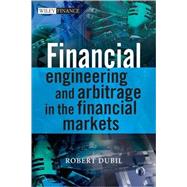Financial Engineering and Arbitrage in the Financial Markets

Financial Engineering and Arbitrage in the Financial Markets
- ISBN 13:
9780470746011
- ISBN 10:
0470746017
- Edition: 2nd
- Format: Hardcover
- Copyright: 10/03/2011
- Publisher: Wiley
Rent
Sorry, this item is currently unavailable.
Note: Supplemental materials are not guaranteed with Rental or Used book purchases.
Extend or Purchase Your Rental at Any Time
Need to keep your rental past your due date? At any time before your due date you can extend or purchase your rental through your account.
Summary
Many students of financial markets and institutions learn a lot of the descriptive details about types of securities and products traded, but do not gain a real insight into what drives people to trade in these markets. They leave the classroom still believing that financial trading firms primarily speculate on the direction of the market movements or earn money from fees. They fail to grasp the concept of relative value arbitrage, which drives most of the trading in today's fast and interconnected markets. This book will teach them what money and capital markets are about through a sequence of arbitrage-based numerical illustrations and exercises enriched with institutional detail. It will explain to the reader what all the people sitting on the trading floors of financial firms do and why they all sit together. The new edition builds on the logic of the first book which is that all financial markets, whether for equity, commodities, currencies or credit, have the same structural building blocks. These are in the increasing order of complexity: spot (cash) transactions (immediate exchanges of cash for asset), forward/futures (pre-agreed-upon future exchanges of cash for asset), swaps (pre-agreed-upon sets of multiple future cash flow exchanges), and options (future exchanges of cash for asset contingent on an event or price level). These contracts are like Lego blocks continuously added together or taken apart by financial engineers to create new structured securities. The main valuation principle is simple: a whole is worth the sum of its parts. Section I explains the structural building blocks outlined above and puts them in the context of financial engineering and investment strategy. Section II is new and offers an overview of financial engineering landscape, from the general asset-backed trust structure to details of tranched mortgage securities, CDOs, exotic options and structured financial products people find offered to them in their brokerage accounts. There are no theoretical discussions of option valuation or calculus, instead Dubil gives established hedging practice, simple cash flow slicing and the building block math. Section III is also new and covers investment topics, including the standard theory of diversification leading on to buy-and-hold diversification .The objective of Section III is to explain the analytical tools used in these investment areas, relate and juxtapose them to relative value analysis of financial engineering, and to provide a deep understanding of the raison d'être/business model of these areas of finance. Contents Chapter 1 - The Anatomy of Financial Markets Chapter 2 - Spot Markets Chapter 3 - Forward Markets Chapter 4 - Swap Markets Chapter 5 - Option Markets Chapter 6 - Credit Derivatives II - Structured Finance and Financial Engineering Chapter 7 - Basics of Cash Flow Engineering Chapter 8 - Mortgage Backed Securities Chapter 9 - CDOs - Collateralized Debt Obligations Chapter 10 - Options Alchemy Chapter 11 - Structured Products With Options III - Investment and Trading Chapter 12 - Portfolio Theory CHAPTER 13 - Individual Investors CHAPTER 14 - Institutional Investors Chapter 15 - Hedge Funds Chapter 16 - Investment Banks, Private Equity and Venture Capital Chapter 17 - New Frontiers (optional chapter)






